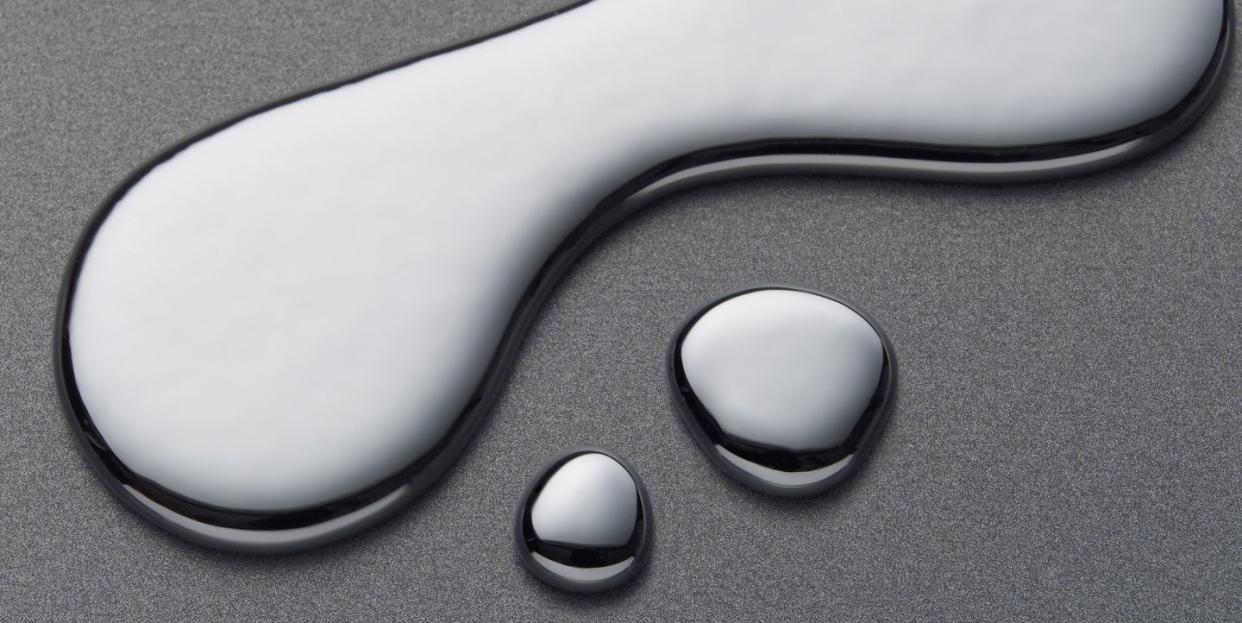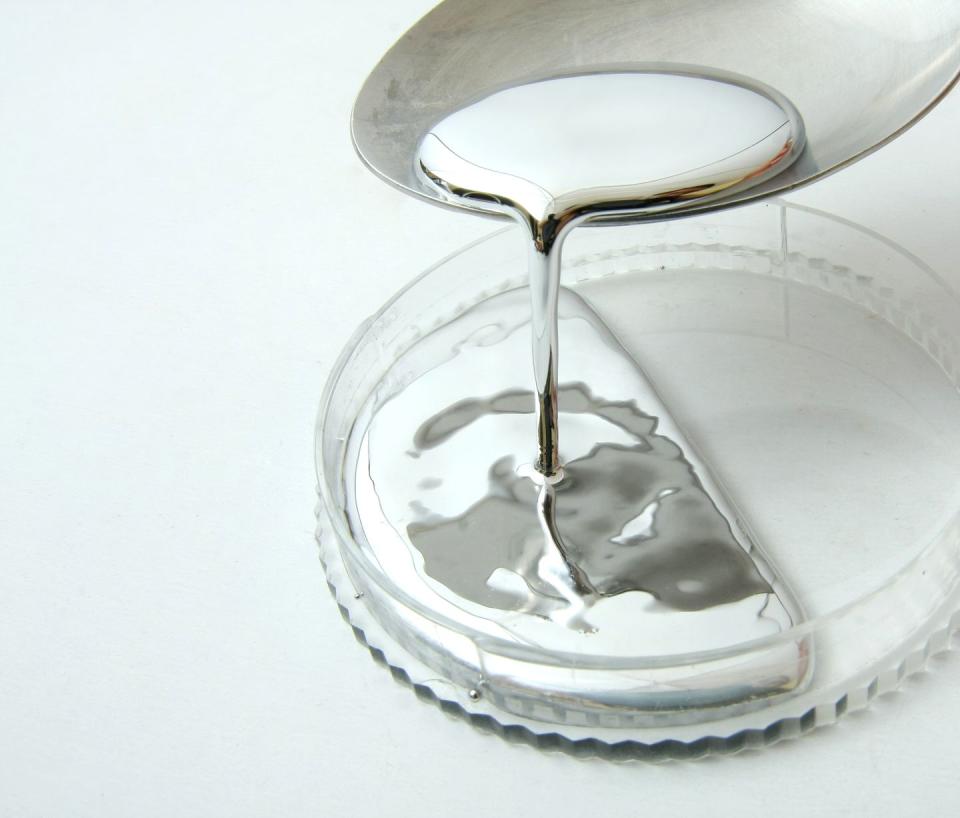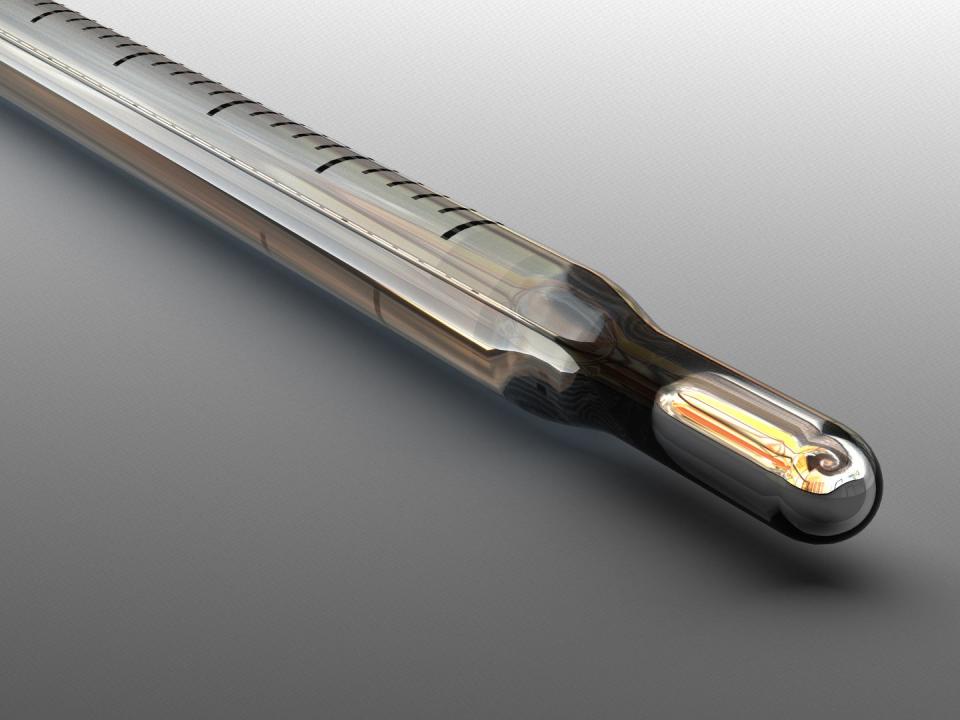Liquid Mercury Is So Damn Weird

Yesterday, we shared this video of an iron anvil floating in a vat of liquid mercury—and then, for good measure, a guy sloshing around in the tub:
It's a fascinating science experiment (albeit one we don't recommend), but it only raises more questions: Where does mercury come from, anyway? How did people find it? And why is it so damn weird?
The Quaintness of Quicksilver

The original Latin name for mercury, hydrargyrum, means “quicksilver:”: the changing, moving, and living form of silver. It’s easy to see why mercury captured people’s imaginations as early as 2,000 B.C., and Aristotle wrote about how to turn the naturally occurring mineral cinnabar into its components mercury and sulfur. Whoever first decided to throw cinnabar into a fire realized the mercury left as vapor that could be collected and recombined into pure mercury. This must have seemed like magic—honestly, it still does—and mercury became one of the most important parts of the ancient take on the periodic table. Gold, mercury, copper, silver, iron, tin, and lead formed the alchemical group called “planetary metals.”
The planet Mercury was the only one with the same name as its associated metal, where both are named after the Roman god of speed, transit, sending messages, luck, and tricks. People learned that mercury was toxic, but they thought it still had value as a medicine, a component of other materials, or a vehicle for chemical reactions. What’s surprising is how much about mercury has stayed the same over thousands of years. Romans used it in paint, and this wasn’t “phased out” until ... wait, 1991?!
Mercury itself was prized as a precious-looking element, the only metal that’s liquid at room temperature. Indeed, despite its increasingly known toxicity, mercury was the basis of alchemical “elixirs of immortality” around the world as people tried to transfer chemical traits like resistance to fungus or tarnish into the human body by, uh, an oral route. Gold dissolved in mercury, leading proto-scientists to guess it was the basis of the other elements in some way.
A Multifaceted Metal

These doomed experiments may have helped lead to the real ways people still use mercury. Mercury bonds easily with all kinds of other metals, like in the dental amalgam fillings many of us have, where mercury is combined with silver to form a paste that hardens into a permanent filling. Pure mercury was given as a medicine to treat syphilis and other diseases, where its obvious worsening of symptoms was just thought to be the progression of disease.
For centuries, mercury has been used in gold mining. Today, millions of people around the world work as so-called “artisanal” gold miners and still use this specific, centuries-old way of extracting gold. They combine mercury with gold ore in order to release the gold, which readily amalgamates with the mercury. For people in poor countries with few opportunities, this dangerous job can seem like a golden parachute. There are better, safer ways to mine gold, but the old-school mercury method is well understood and easy to do, especially when people feel they don’t really have a choice.
These mines create mercury pollution in the air and water, and like the waste from industrial use of mercury, the runoff makes its way into waterways. This is where fish end up consuming high amounts of mercury, which makes its way up the food chain from bottom-feeders. In turn, the Centers for Disease Control and Prevention and other bodies have issued “best practices” about consumption of seafood. In 2008, actor Jeremy Piven made headlines (and punchlines) when he left a Broadway gig and said he had mercury poisoning from eating too much sushi.
Pure mercury is still used in plenty of devices where it’s useful as a readymade liquid conductor or, as in thermometers, where its temperature expansion is so dramatic and predictable that we use it to measure body heat. Students in chemistry classes might have one drop of mercury in a sealed glass jar so they can observe it, but handling mercury is typically the realm of trained scientists with safety equipment.
In the 1980s, a major plant in Vermont closed when its safety-minded workers were nonetheless found to be full of mercury: “in the air of workers’ homes, on their clothing and furniture, and most tragically, in the bodies of many workers and their children,” Dartmouth’s Superfund Research Program says. Dartmouth University’s connection is personal, too. A faculty member died in 1997 months after just a few drops of “highly toxic” dimethylmercury touched her skin through a leaky glove.
Chemically, mercury is as special as its unusual appearance indicates. It behaves more like a noble gas than a metal, surrendering its electrons only very reluctantly. It’s one of the densest elements, ranking in the teens and surrounded by heavy—and solid—metals. Because of this, it’s popular in demonstrations of buoyancy and comparative density, like our friend who floated an anvil in a vat of it for his YouTube channel. (“There’s a hole in my glove,” he says nonchalantly, before shaking it out.)
One of the startling things in the anvil video is seeing how the mercury beads up and falls away from the anvil surface no matter what. It’s pure Terminator, and not “wet” in the sense that water is wet. One reason is because the surface tension within mercury is so strong that drops of it adhere to each other more than they’d break ranks to adhere to another surface. Water forms a U-shaped meniscus in a test tube, but mercury’s top makes a dome because of how much it resists adhering to anything. (This is another reason it’s great in thermometers.)
For viewers at home, looking at videos of mercury online, and online only, is the best way to see how cool mercury can really be. Even safely handling mercury is still stressful and requires special preparation. Learn from millennia of aspiring immortals, syphilitics, and sushi over-consumers, and just say no.
You Might Also Like

